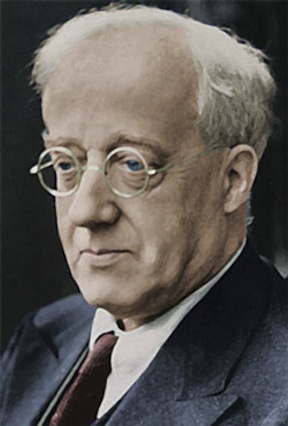The Well-Tempered Ear
Classical music: The Wisconsin Chamber Choir turns in an outstanding performance of music by British composer Ralph Vaughan Williams and his musical “friends.” But the fine singing deserved an orchestra, not just organ and violin, for the famous Serenade to Music.
1 Comment
By Jacob Stockinger
Here is a special posting, a review written by frequent guest critic and writer for this blog, John W. Barker. Barker (below) is an emeritus professor of Medieval history at the University of Wisconsin-Madison. He also is a well-known classical music critic who writes for Isthmus and the American Record Guide, and who hosts an early music show every other Sunday morning on WORT FM 89.9 FM. He serves on the Board of Advisors for the Madison Early Music Festival and frequently gives pre-concert lectures in Madison.
By John W. Barker
Robert Gehrenbeck and his Wisconsin Chamber Choir (below) gave an entirely English choral program as the conclusion of their season on last Saturday night.
And, despite the heat, and the frightfully uncomfortable pews of Grace Episcopal Church on the Square — not to mention the competition of the Con Vivo chamber music concert — a considerable audience turned out to hear it.
The program took as its theme “Ralph Vaughan Williams (below, 1872-1858) and Friends,” highlighting the work of one of the most important composers of the 20th century, but one whose music still has not been taken up sufficiently in our country. (When was the last time you heard one of the great nine symphonies of “VW” played by an American orchestra?)
The beginning of the program was rightly dominated by Vaughan Williams. After an elaborate Psalm setting, titled “A Choral Flourish,” a Latin motet by Thomas Tallis (below, ca.1505-1585) provided context for VW’s great a cappella Mass in G Minor—though, alas, only its first two movements. Like the composer’s famous Fantasia on a Theme of Thomas Tallis, the writing cleverly opposes soloists, and small and larger groupings against each other. (I note for the record that there were a few moments of intonation problems.)
Next came an English hymn by Imogen Holst (below top, 1907-1984), daughter of VW’s dear friend and colleague, Gustav Holst, and an anthem from an Anglican service by Herbert Howells (below bottom, 1892-1983), one of VW’s devoted disciples.
The “Psalm tune” by Thomas Tallis (if with a modernized English text imposed) was a noteworthy gem, familiar, of course, as the subject for VW’s Tallis Fantasia, already mentioned, followed naturally by another of VW’s elaborate settings of Psalm 90, “Lord, Thou has been our refuge”—again, a piece that juxtaposed a small group (vocal quartet, below) against a larger (full choir).
Following the intermission, three of VW’s arrangements of examples from his favorite source, English folksongs, these about sailors.
There followed the one serious mistake of the program: VW’s Serenade to Music. This is a lovely setting of Shakespeare’s wonderful tribute to music in lines from Act V of The Merchant of Venice. It was composed in 1938 to honor conductor Sir Henry Wood and his orchestra, featuring 16 singers with whom he had worked. VW allowed the 16 solo lines to be adapted for full chorus, and Gehrenbeck’s compromise was to have 13 singers in the choir sing specifically solo lines, while their joint parts were taken by the full choir.
It was a shaky compromise, hindered by the fact that some of the choir soloists were not quite equal to their assigned solos. Most disastrous of all, however, was the substitution for the orchestral role of a solo violin and organ.
Violinist Leanne League (below top), who plays with the Madison Symphony Orchestra and the Wisconsin Chamber Orchestra, fiddled very beautifully, and organist Mark Brampton Smith (below bottom) played well. But violin and organ do not an orchestra make. This piece just should not have been attempted this way in this program. (You can hear an orchestral version of The Serenade to Music, with the London Symphony Orchestra conducted by Sir Adrian Boult, at the bottom in a YouTube video. Be sure to read the listener comment about the Serenade to Music reduced Sergei Rachmaninoff to tears.)
Two short and supposedly humorous pieces about animals, composed by Elizabeth Maconchy (below, 1907-1994) were awfully trivial: I would gladly have sacrificed them for the rest of the Vaugah Williams’ Mass in G Minor.
Finally, to restore some balance, there were three folksong arrangements by Gustav Holst (below, 1874-1934) himself—the last of them, the “Blacksmith’s Song,” familiar to many in its alternate treatment as a movement in Holst’s Suite No. 2 for Band.
One thing that concerned me throughout was the question of section organization. Up to Imogen Holst’s piece, the chorus was grouped by voice parts. But thereafter the singers were repeatedly scrambled, breaking down such part groupings. This is a practice now favored by many choral directors, who will use the argument, among others, that such scrambling furthers blending.
But blending can be achieved at the price of structural clarity. In much of the program’s music there was a great deal of unison writing, or very simple chordal writing, and the strength derived from the blending was truly powerful.
But in other cases, the interaction of parts was muddled. The prime example was the sturdy Tallis Psalm: its “tune” is in the tenor part, which should have had a united prominence but was instead dispersed and diluted.
I have raised this issue before, and I will continue to do so, no doubt to much scoffing.
That issue aside, the program demonstrated the wonderful choral sound that Gehrenbeck (below) has developed with these 33 singers. They sing their hearts out for him, but in suavely balanced ensemble that is a joy to hear.
It is clear by now that Gehrenbeck, who directs choral activities at the University of Wisconsin-Whitewater, has set a new standard for choral singing in Madison, and has a lot to offer us in times ahead.
Tags: a cappella, American Record Guide, Arts, British music, Chamber music, Choir, choral music, Early music, Elizabeth Maconchy, England, English music, Episopal, Fantasia on a Theme by Thomas Tallis, Great Britain, Gustav Holst, Henry Wood, Herbert Howells, History, Holst, Imogen Holst, Isthmus, Jacob Stockinger, Madison, Madison Early Music Festival, Madison Symphony Orchestra, mass, Mass in G Minor, Merchant of Venice, Music, organ, Rachmaninoff, Rachmaninov, Ralph Vaughan Williams, Robert Gehrenbeck, Serenade to Music, Sergei Rachmaninoff, Sergei Rachmaninov, Shakespeare, Sir Henry Wood, Thomas Tallis, UK, United Kingdom, University of Wisconsin-Whitewater, University of Wisconsin–Madison, Violin, William Shakespeare, Wisconsin, Wisconsin Chamber Choir, Wisconsin Chamber Orchestra, WORT-FM 89.9, YouTube















